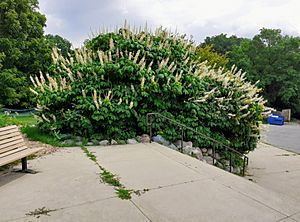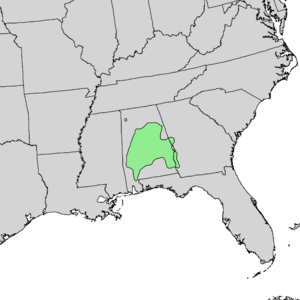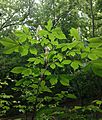Bottlebrush buckeye facts for kids
Quick facts for kids Bottlebrush buckeye |
|
|---|---|
 |
|
| Conservation status | |
| Scientific classification | |
| Genus: |
Aesculus
|
| Species: |
parviflora
|
 |
|
| Generalized natural range | |
| Synonyms | |
|
Synonymy
Aesculus alba (Poir.) Raf.
Aesculus macrostachya Michx. Aesculus macrostachys Pers. Aesculus odorata F.Dietr. Aesculus parviflora f. serotina Rehder Macrothyrsus discolor Spach Macrothyrsus odorata Raf. Nebropsis alba (Poir.) Raf. Pavia alba Poir. Pavia edulis Poit. Pavia macrostachys Loisel. Pavia parviflora Raf. Pawia parviflora Kuntze |
|
The bottlebrush buckeye, also known by its scientific name Aesculus parviflora, is a type of shrub that loses its leaves in the fall. It grows by sending up new shoots from its base. This plant belongs to the Sapindaceae family, which also includes maples and horse chestnuts.
This shrub is originally from the southeastern United States. You can mostly find it in Alabama and Georgia. There's also a separate group of these plants in South Carolina, near the Savannah River. The bottlebrush buckeye naturally grows in moist forests, on cliffs, and in deep valleys called ravines.
It's important to know that this plant is harmful if eaten by humans. Eating it can cause muscle weakness, problems with movement, throwing up, and diarrhea. It has also been reported to be unsafe for pets.
Contents
What Does the Bottlebrush Buckeye Look Like?
The bottlebrush buckeye typically grows to be about 2 to 4 meters (6 to 13 feet) tall. Its leaves grow in pairs on opposite sides of the stem. Each leaf is made up of 5 to 7 smaller leaflets, like fingers on a hand. These leaflets are about 12–22 centimeters (5–9 inches) long and 5–10 centimeters (2–4 inches) wide. They have smooth edges.
Flowers and Seeds
The plant produces beautiful flowers that grow in tall, upright clusters. These clusters can be 20–50 centimeters (8–20 inches) long and look a lot like a traditional bottle brush. Each flower has a tube-shaped base, small white petals, and several long stamens (the parts that hold pollen) that stick out 3–4 centimeters (1–1.5 inches).
After the flowers bloom, they turn into pear-shaped capsules. Inside these capsules, you'll find shiny, brown seeds. The scientific name parviflora comes from Latin and means "small-flowered," even though the flower clusters are quite large!
Where Does the Bottlebrush Buckeye Grow?
The bottlebrush buckeye is a popular plant to grow in gardens because of its attractive flowers. When it blooms in August, its flowers are a great source of nectar for butterflies.
Growing Conditions
This plant prefers soil that is moist but drains well. It grows best in places that have some shade or full shade. In the US, it can grow well in USDA hardiness zones 4 through 8. This means it can handle a range of temperatures, from quite cold winters to warm summers.
History of Its Discovery
The famous naturalist and explorer William Bartram was the first to notice this shrub. He found it during his travels through Carolina, Georgia, and Florida between 1773 and 1778. Even though an old plant was still growing in Bartram's Garden in Philadelphia in 1930, the bottlebrush buckeye has not become very common in gardens in the eastern United States.
The plant was brought to British gardens by John Fraser. He made his first trip to collect plants in the American South in 1785. Fraser shared his plant discoveries with English plant nurseries like Lee and Kennedy or Loddiges, and also with private plant lovers. By 1820, the shrub could be found in most nurseries in Britain. This plant has even won an award from the Royal Horticultural Society called the Award of Garden Merit, which shows it's a great plant for gardens.
Images for kids
See also
 In Spanish: Aesculus parviflora para niños
In Spanish: Aesculus parviflora para niños








